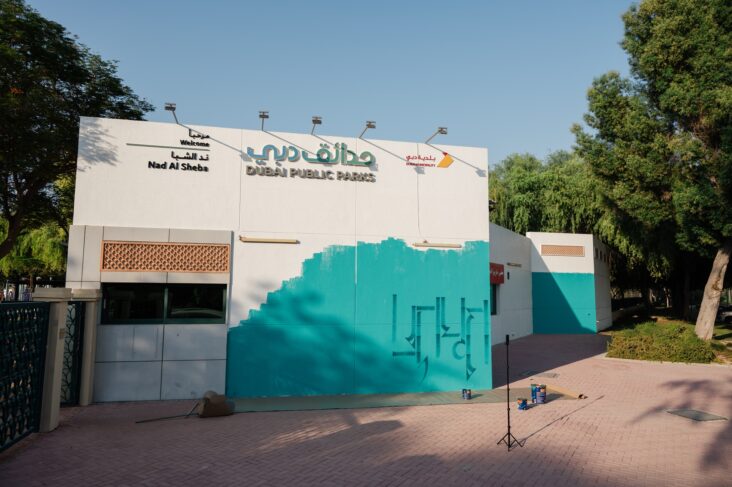
Public art is a core element of Dubai’s broader arts ecosystem. Through its diverse projects, the emirate continues to showcase its unique appeal and the vibrancy of its art scene, which stands out for its diverse and exceptional experiences. Dubai is home to inspiring works, installations, and murals that support the strength of the Public Art Strategy – a strategy to transform the city into an open-air art gallery accessible to all. This vision aligns with the Dubai 2040 Urban Master Plan, which seeks to achieve sustainable urban development pivoted around people, while reinforcing its position as a preferred destination for living, working, and leisure – as well as a global centre for culture, an incubator for creativity, and a thriving hub for talent.
Through the mural projects being implemented across various areas of the city, the Dubai Culture and Arts Authority (Dubai Culture) aims to support creatives and talent, spark their innovation, and enable them to contribute to turning Dubai’s neighbourhoods, public spaces, and districts into inspiring cultural and tourism destinations. These murals reflect the emirate’s distinct creative identity and foster a civil and interactive space between artists and audiences from all nationalities and cultures. This also helps establish a sustainable environment that encourages artists to pursue their passion, express themselves, engage with the community, raise public artistic taste, and beautify the various areas. All of this aligns with the goals of Dubai’s Creative Economy Strategy and supports Dubai Culture’s sectoral priorities and responsibilities in strengthening the cultural and creative industries.
Recently, the Authority has completed a wide range of these artworks. Among the most notable is the heritage-inspired, gypsum mural adorning the facade of the Al Safa Art and Design Library, created by Lebanese artist Chafa Ghaddar. The work depicts the city’s diversity and vibrancy, reimagining the original architecture of the library and showcasing the aesthetic and precision of Islamic ornamentation that once adorned the building before it underwent comprehensive restoration. Ghaddar used the classic Azulejos ceramic technique, a key element of Portuguese architectural styling influenced by Islamic, Chinese, and Spanish arts.
In another example, the UAE-based Argentinian Yubran Gosne (aka Sanctum), created the mural ‘The Tide’ in Umm Suqeim Park, drawing on the movement of waves and the meeting of water and sand – echoing Dubai’s deep-rooted connection to the sea. It consists of a large four-part panel using shades of green, blue, and turquoise to express the relationship between water and land.
Meanwhile, Algerian artist Ahmed Amine Aitouche (Sneak Hotep)is responsible for the mural ‘Amalgamation’ in Nad Al Sheba Park, made up of three surfaces seamlessly painted to appear as one. Through it, the artist reflects how Dubai embodies cultural coexistence and balance – between tradition and modernity, freedom and discipline – and how this balance contributes to both urban and social growth.In Abu Hail Park, Aitouche’s ‘Epitome’ is a silent message for all striving to become better versions of themselves every day.
One of the earliest permanent public artworks in Al Quoz Creative Zone was ‘Unified’, a collaborative mural by Tunisian calligraffiti artist Karim Jabbari and American designer Jaime Brown. Created five years ago, the piece signalled a shift in the district’s evolution from industrial zone to cultural destination. Inspired by the words of His Highness Sheikh Mohammed bin Rashid Al Maktoum, the mural reflects on how art transcends language and background to bring people together. Developed through on-site improvisation and community dialogue, it fuses Arabic calligraphy with contemporary design, capturing the spirit of Al Quoz Creative Zone as a place where heritage and innovation meet in public view.
During the Sikka Art and Design Festival, a flagship initiative under Dubai’s Quality of Life Strategy – Dubai Culture is committed each year to presenting a remarkable collection of inspiring murals that provide a platform for artists to express their visions and perspectives. The 13th edition of the festival, held last February in the Al Shindagha Historic Neighbourhood, featured 13 murals distinguished by their artistic styles and innovative ideas. Through colour, movement, and form, the artworks explored themes central to the city’s ongoing social and cultural evolution – including the strength and presence of Emirati women in shaping its identity.
Murals are one of the most expressive elements of Dubai’s modern cultural landscape – bridging eras, perspectives, and communities. As Dubai Culture continues its work in public spaces with governmental initiatives that support that, new districts and neighbourhoods will present fresh surfaces for artists to explore. These artworks undoubtedly bring colour to the city, but more than that, they create enduring moments of connection.

